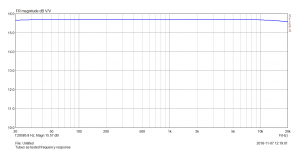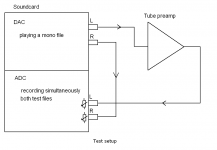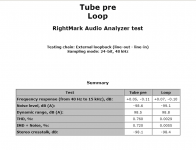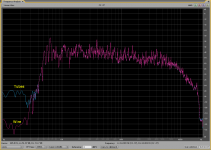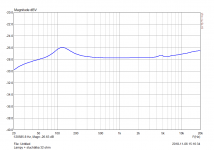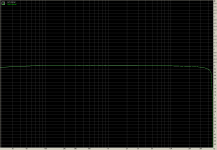Pavel, I find your experiment posts educational, science-minded, intriguing, very interesting and possibly the most original contributions in this forum. I also like the group involvement aspect.My goal is to put some of them back to the ground, though I know very well this would not help much and that the belief in any kind of nonsense will go on. And the high-end audio needs it for its existence.
I say it is helpful, thank you and please continue.
Hi George,
not sure what you mean. The tube stage has BW(-3dB) > 300kHz.
Robert claims the “through the buffer” file has it’s midrange ‘sucked out’ compared to the “through the wire” file.
My hearing freq response is highly compromised , so a subjective confirmation of the buffer's frequency response flatness would be good to see.
George
Robert claims the “through the buffer” file has it’s midrange ‘sucked out’ compared to the “through the wire” file.
My hearing freq response is highly compromised , so a subjective confirmation of the buffer's frequency response flatness would be good to see.
George
OK. First, I would like to mention that it is not any buffer, but it is a gain stage with voltage gain almost 16dB. Please find attached frequency response measurement, it is calibrated so the Y axis shows gain directly. One can see that the flatness in audio band is within 0.1 - 0.2dB. It is measured in the exactly same setup used for the test recording. Above audioband, the freq response is extended to hundreds of kHz, with the -3dB roll off point above 300kHz. There is no reason for what you are describing. Robert has not done a DBT AFAIK and has changed his impressions during the time.
Attachments
It may be my imagination, but that plot shows a very slight hint of midrange boost - which is exactly what you might expect an amplifier to do with simple rolloffs at frequency extremes. Other things being equal, the peak response would be at the geometric mean of the corner frequencies. No 'suck out' visible there.
Maybe the wire gives a bigger midrange boost, so by comparison the amp 'sucks'? As I said, you must have used the wrong wire!
Maybe the wire gives a bigger midrange boost, so by comparison the amp 'sucks'? As I said, you must have used the wrong wire!
I am not sure if it might be audible if there is a very slow change in the whole band and is about 0.1dB, maybe 0.2dB at the upper end. IMO this is inaudible.
I made another test, I loaded the circuit with 32 ohm headphones. Surprisingly, the distortion remained in order of 0.1%, only amplitude dropped, because of rather high tube circuit output impedance. SRPP is known of its ability to drive low impedance load. There was another side effect, frequency response became modulated by headphone impedance curve and there is a 2 dB (broad) resonance peak at some 120Hz. I recorded the same sample, equalized level and now it became distinguishable in a DBT, I get repeatedly something like 7/8. But the sound difference is surprisingly not too big. So, this 2dB broad peak makes a difference, but I doubt that the 0.1 - 0.2 dB drop at the ends of the band in the test file here is audible at all.
I made another test, I loaded the circuit with 32 ohm headphones. Surprisingly, the distortion remained in order of 0.1%, only amplitude dropped, because of rather high tube circuit output impedance. SRPP is known of its ability to drive low impedance load. There was another side effect, frequency response became modulated by headphone impedance curve and there is a 2 dB (broad) resonance peak at some 120Hz. I recorded the same sample, equalized level and now it became distinguishable in a DBT, I get repeatedly something like 7/8. But the sound difference is surprisingly not too big. So, this 2dB broad peak makes a difference, but I doubt that the 0.1 - 0.2 dB drop at the ends of the band in the test file here is audible at all.
They sound very close to me. I think that file 2 has a bit more reverb when I listen in 4 channel mode (faux surround). Not sure how I can blind ABX that, but will try.
Thanks for trying the files.
ABX is quite easy with foobar
foobar2000
and its ABX plug-in
foobar2000: Components Repository - ABX Comparator
Foobar has not been working for me lately, I don't know why. And I'll need some other processing to get the 4 channel format where I think I heard the differences. Will work on it.
If you have a good solo violin recording that would be interesting. Would the tube distortion alter the harmonics of the string timbre enough to be noticeable? Cello could work as well.
If you have a good solo violin recording that would be interesting. Would the tube distortion alter the harmonics of the string timbre enough to be noticeable? Cello could work as well.
ABX test - Wikipedia
the Foobar player has a plugin that allow this to be done and a score generated.
the Foobar player has a plugin that allow this to be done and a score generated.
I would like to tell a bit more about the test setup and arrangement. Block diagram of the test circuit is attached. The soundcard was playing a mono file. Left channel of the DAC was connected to the tube preamp input, tube preamp output was connected to left channel ADC input. Right channel of the DAC was connected directly to the right channel ADC input.
A stereo file was recorded, simultaneously tube channel and wire channel. A stereo file was then split into two mono files. Levels were equalized within 0.1dB order. Two mono files were posted as test files.
It should be noted that the loopback test arrangement eliminates possible soundcard jitter, as the clock is common for ADC and DAC.
Further attachment shows Rightmark analyzer result for both wire (loop) channel and tube channel.
Attached is also a sample of spectrum of both test files taken at the same time interval (precision to 1 sample). One can see that the spectra are identical except for frequencies below 40Hz, where we can see some noise/hum of the tube preamp, however no useful music signal.
A stereo file was recorded, simultaneously tube channel and wire channel. A stereo file was then split into two mono files. Levels were equalized within 0.1dB order. Two mono files were posted as test files.
It should be noted that the loopback test arrangement eliminates possible soundcard jitter, as the clock is common for ADC and DAC.
Further attachment shows Rightmark analyzer result for both wire (loop) channel and tube channel.
Attached is also a sample of spectrum of both test files taken at the same time interval (precision to 1 sample). One can see that the spectra are identical except for frequencies below 40Hz, where we can see some noise/hum of the tube preamp, however no useful music signal.
Attachments
Last edited:
BTW, Foobar is working just fine now and I ran a 16 trial test.
I was fairly sure I could hear a difference. Foobar says 77% chance that I was guessing.
This is quite typical, I have a similar result
You may try another file, called ella3, this was recorded through the tube preamp loaded with 32 ohm headphones. The link is below and also a plot that shows what it makes with a frequency response.
http://pmacura.cz/ella3.zip
This file is not a test file for the poll !!!!
To me, this (and not the distortion) illustrates what is that so called "tube sound". A modification of frequency response by load impedance curve and it happens with tube power amplifiers, because of their usually high output impedance.
Attachments
Off topic
I think the good tube sound is more the harmonic profile like:
CARY SLI-80 SIGNATURE
[Polish] CARY SLI-80 SIGNATURE - Wzmacniacze stereo | Testy w Audio.com.pl

I like more this profile:
QUAD II Classic Integrated
[Polish] QUAD II Classic Integrated - Wzmacniacze stereo | Testy w Audio.com.pl

The ideal to me, tubes or SS, only H2 at 70-75 dB. H3 at least 10dB below and nothing else up to 90 dB.
To me, this (and not the distortion) illustrates what is that so called "tube sound". A modification of frequency response by load impedance curve and it happens with tube power amplifiers, because of their usually high output impedance.
I think the good tube sound is more the harmonic profile like:
CARY SLI-80 SIGNATURE
[Polish] CARY SLI-80 SIGNATURE - Wzmacniacze stereo | Testy w Audio.com.pl

I like more this profile:
QUAD II Classic Integrated
[Polish] QUAD II Classic Integrated - Wzmacniacze stereo | Testy w Audio.com.pl

The ideal to me, tubes or SS, only H2 at 70-75 dB. H3 at least 10dB below and nothing else up to 90 dB.
Another measurement of the frequency response of the tube preamp under test, measured with another soundcard at 96kHz sample rate (that means there can be nothing above 48kHz and above 40kHz there is a fast souncard roll off). There is nothing to indicate any midrange "suck-out".
Attachments
The ideal to me, tubes or SS, only H2 at 70-75 dB. H3 at least 10dB below and nothing else up to 90 dB.
Inaudible, makes no sound coloration. And easily achievable with solid state.
- Status
- This old topic is closed. If you want to reopen this topic, contact a moderator using the "Report Post" button.
- Home
- General Interest
- Everything Else
- Do you like tube distortion? - listening test
